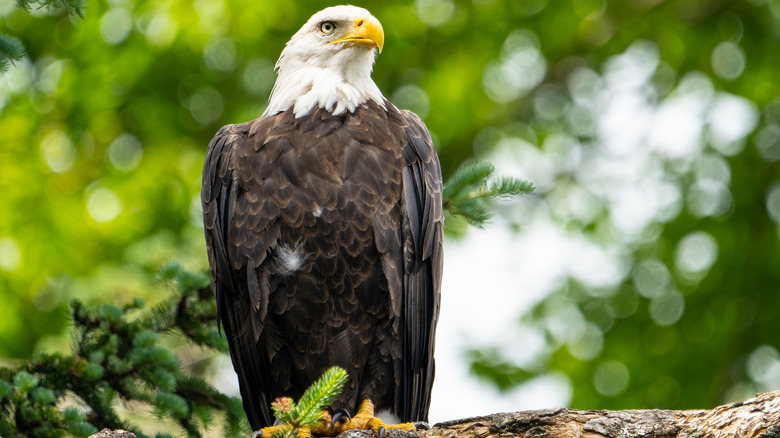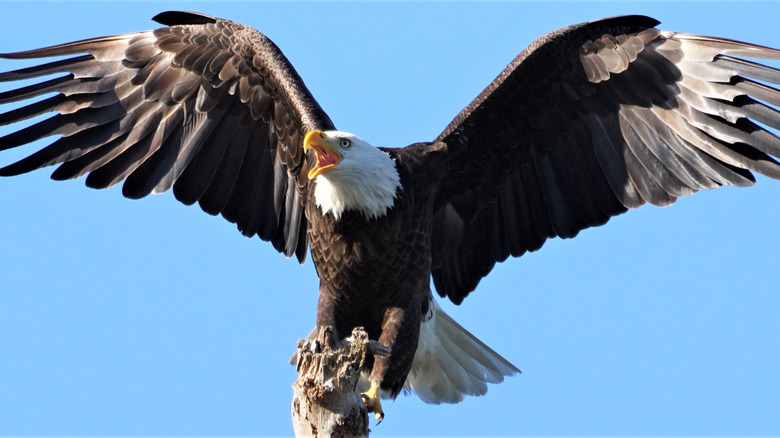What Really Happens If You Kill A Bald Eagle?
Since 1787, the bald eagle has been the United States' national bird, being given that designation when Congress officially added it to the country's emblem, according to Live Science. The august and handsome bird, a crown of white feathers juxtaposed with its brown body, its yellow eyes focused on its prey, projects the image of strength and authority.
In fact, there's nothing particularly American about eagles, although the bald variety is a uniquely North American version of the bird, according to the National Wildlife Federation. Other species of eagle are found all over the world, according to TheBirdPedia, and indeed, eagles have been symbols of government and authority since Roman times.
For a time in the latter half of the 20th century, it looked like the U.S. was perilously close to losing its national symbol to extinction. Pesticides, trophy hunting, and the realities of human habitation had driven the once-abundant bird to only a few thousand specimens. Legislation was introduced to protect the animal, and today, it's no longer endangered. However, laws about mistreatment of bald eagles remain on the books, and those who break them, even unintentionally, can find themselves in extremely hot water.
The Bald Eagle Is Saved From Extinction
When European settlers arrived on the landmass that would become the United States of America, bald eagles were seen as competition for fish and other scarce resources and were usually shot on sight, according to Boston.com. Over the next couple of centuries, expanding human settlement, combined with wonton deforestation, would reduce the birds' habitat and numbers even further. However, the biggest threat to the birds' existence came in the 1940s, with the development of the pesticide DDT. The chemical was particularly destructive to the birds, and by 1963, there were only a few hundred nesting pairs of the birds in the lower 48 states.
In the early 1970s, the U.S. began an aggressive campaign of protecting and bringing back the bald eagle. The plan started with banning DDT, but also included laws against molesting the birds (or their eggs or nests), as well as breeding programs.
Thanks to these efforts, the bald eagle is now considered "least concern" by the International Union for Conservation of Nature, according to ThoughtCo, and its population has rebounded. However, the laws that helped protect the bird in the first place remain on the books, and are still enforced.
Fines Start At $5,000, Even For Accidents
Even though the bald eagle is once again thriving after being driven to the brink of extinction, laws protecting the bird are still in place, and they come with harsh penalties for breaking them.
As Nicky Featherstone writes in Forest Wildlife, under the Bald and Golden Eagle Protection Act of 1940 killing a bald eagle can result in fines of up to $5,000 and even jail time for a first offense in civil law cases. In reality, though, these matters are handled on a case-by-case basis, and a judge may not necessarily impose prison time, or even harsh fines (or any fines) if there was no negligence or malicious intent. Of course, if the killing was intentional, all bets are off. First offenders can be fined up to $100,000 for a first offense.
In 2019, two Michigan men found out the hard way that the government is zealous about protecting eagles, even those killed unintentionally. As the Great Lakes Echo reported, two men shot what they thought was a goose. Unfortunately, it was a bald eagle, and they were facing prison sentences and fines beginning at $5,000.


